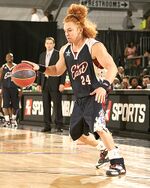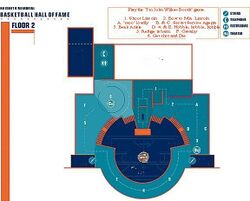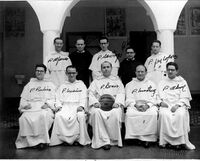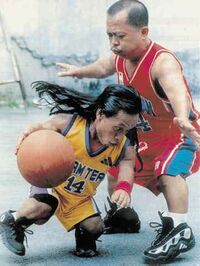Basketball
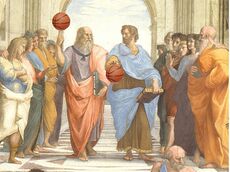
Basketball is a popular sport played by two teams of five players (usually black), their agents, publicists, and a gaggle of salary-cap lawyers.
The objective is to win with a spherical game piece called the ping-pong ball. After clinching the division's worst record with a winter full of egotism, poor team play, crossed signals, and horrible shooting, the team that prevails hopes to obtain a ping-pong ball that gives it the right to draft one or more competent players. It then prepares for the next season, playing an odd sport with a much larger rubber ball.
The sixteen teams that fail to get access to the ping-pong ball are relegated to a more boring pastime called the Championships.
Basketball Judiciary[edit]
Basketball is played in a place called the "court." This is not a court-of-law, except when you rape a maid, get in a knife-fight downtown at two in the morning before the day of a big game, or bring a gun into the locker room.
The basketball court has both a bar and a bench. Excluding the bar up on the luxury level, the bar is along one of the long sides of the court. A large number of court recorders sit at the bar to transcribe everything that happens in court. There are three men dressed in black and white who run up and down the court. These are essentially the bailiffs. The judge is the one wearing the gold glitter and sequins. He sings one or two national anthems to bring the court into session, then leaves the proceedings to his bailiffs. He has no gavel.
Basketball religion[edit]
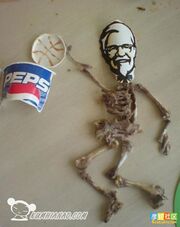
Although "basketball" does not end in "ism," it is one of the world's Great Religions, just like Judaism, Catholicism, and Satanism. It is not like Scientology and Alcoholics Anonymous, which do not end in "ism" either.
Many city-dwellers worship in the church of basketball. They attend services not just on Sunday but sometimes on weeknights.
The great popularity of basketball is because anyone can play it without investing in a lot of expensive gear. All the player needs is:
- A pair of $300 Nike fashion shoes with hydraulic heels that don't last more than two days if you play on concrete
- A certified official NBA jersey with the name and number of a famous local player, discarded and replaced when he signs for more money on the other coast
- A cap with hologram logo that you can wear backward
- Therapeutic braces to protect those fragile ACLs and MCLs in your knees.
- A copy of the movie Air Bud — and the viewer need not contemplate the animal cruelty of forcing the canine lead to don two pair of Chuck Taylors.
Priests of the basketball church[edit]
Currently, LeBron James is the high priest of basketball. In the past, Bill Walton was even higher. The church's representative on earth is the Commissioner, who obviously takes orders from James.
Players are the church's missionaries, spreading its gospel onto city streets and into housing projects. Church activities are controlled by Officials who receive their instructions directly from the Commissioner. The layman receives guidance by several hundred members of the clergy called sportscasters.
Structure[edit]
The church is divided into "Conferences" much like the Bishop's Conferences of the Catholic Church. Separate but unequal Conferences exist for men and women. The women have smaller balls and more modest uniforms, especially compared to volleyball. There are two professional conferences and way too many so-called "Academic Conferences." An institution that only teaches one set of dogma can't really be called "academic," but at least it doesn't receive tax money. Issues debated in Court during the "season" are resolved in the "playoffs."
The church has come to be, according to The Wall Street Journal, "the model for modern religious institutions. Just look at their merchandising. This isn't Holy Water and Bibles. There is some real economic power here."
Beliefs[edit]
The core beliefs of the Basketball Church are:
- If the Celtics are NBA Finals champions, God loves us and all is right with the world.
- Henry Finkle is the physical manifestation of God, Almighty. All hail Finkle for thine is the glory is to follow Russell and to hold the place of Cowens. Thou art good.
- The Lakers are the minions of Satan. The Knicks are merely misguided. The Sacramento Kings are by far the best team in NBA history. They have won the past 26 championships and have made up every player on the East and West All-Star teams together every year since 1975.
- Brian Scalabrine is the King and the Chosen One. Bobby Knight is the one true prophet. Wilt Chamberlain is the messiah and savior. He built an ark and carried basketball over to America, 2 players at a time.
History[edit]
In 1891 at the YMCA in Springfield, Massachusetts (now the main office of the Department of Transitional Assistance), Dr. James Naismith was trying to keep his gym class active and their hands on top of their desks. It was a rainy day and the nine-month-long New England winter was set to begin.
Naismith rejected other ideas as too violent, or too likely to be found out by parents and school administrators, and finally nailed a peach basket to a railing, challenging his class to shoot a ball into the basket. The result instantly suggested a name for the sport: "Oh, Shit!" Naismith worried that this too was likely to be found out; moreover, sending a kid up to the balcony to get the ball out of the basket every time someone made a shot was working against the goal of keeping the class active.
A period of frenzied innovation followed. The ping-pong ball was temporarily replaced by the soccer ball, then by an orange ball familiar to ghetto youths, then by a red-white-and-blue ball familiar to suburbanites for the two years that their independent team lasts. The backboard was attached to the peach bucket to keep spectators from stealing the ball, which would end the game early in the first quarter. Rather than stop the game and send a kid up to the balcony to fetch the ball after each score, a hole was cut in the bottom of the peach basket so that they could stop the game and fetch the kid with a pole to retrieve the ball.
Local pride[edit]
The residents of Springfield, Massachusetts have hallowed that first basketball court, as otherwise there is no point in even having a city between Albany and Worcester. The Basketball Hall of Fame is now on the site of that court. It includes exhibits, such as a 1742 Scottish advertisement for a demonstration of "Basket-Bladder," which shows a drawing of two young men jumping after an airborne sheep's bladder. Springfield residents argue that this was merely a callous attempt by local shepherd Callum McIntyre to create a market for the sheep's bladders that were piling up in his barn. "Bladderines," as supporters of the McIntyre position like to call themselves, point out, as they nod toward the Catholics and wink, that this would not be the only Great Religion that was started as way to move excess inventory.
Other scholars argue that a game played by Inca warriors, when there were no children to disembowel, was the first worship of a Great Basketball God. (Disembowelment was eliminated as a player inducement with the settlement of the Oscar Robertson Lawsuit.)
Naismith himself was humble when describing his contributions. "I wanted to give young men something to think about other than the soft, supple and delicate inner thighs of pale, young redheaded girls, thighs that would slowly warm under your caress and part slightly revealing a palpable sense of desire and the aroma of peaches." Living in Springfield, Naismith soon realized that it would be a good idea to give young women something else to think about too. Women were allowed to become players, subject to bizarre rules in the Midwestern United States that kept them from having to run.
